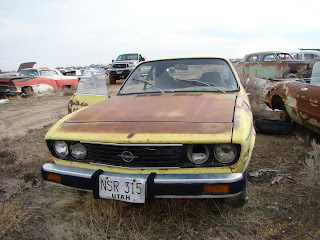 Above: Early Honda 4WS prototype using two Accord front-ends sectioned together. Note the red tail/headlights.
Above: Early Honda 4WS prototype using two Accord front-ends sectioned together. Note the red tail/headlights.In the late 1970s, Honda began researching the possibility of four-wheel-steering as a way of improving upon the basic fundamental design of the automobile. It was an ambitious project for a company, which, up to that point, had only been building cars for a decade or so. They recognized the advantages of having all four wheels steer a vehicle, though the issue would become more complex when choosing between a set of rear wheels that steers in the same or the opposite direction of the front set.
If the rear wheels steer in the opposite direction, the turning radius of the vehicle is reduced (in this case, about 3 feet) and tight-turns become easier to maneuver.
 However, same-direction steering allows for rapid changes in lateral movement - such as passing maneuvers - with far less actual rotation of the car's body.
However, same-direction steering allows for rapid changes in lateral movement - such as passing maneuvers - with far less actual rotation of the car's body.
Honda opted against picking one method or the other and engineered a mechanism to allow the rear wheels to steer in parallel with the front at slight steering angles, but opposite of the front under tight angles. A separate steering gearbox at the rear of the car performed the complex task of aligning the rear wheels via a solid shaft from the front of the car.


By using planetary gears and eccentric shafts, they were able to allow the rear wheels to turn in one direction, then re-center, and steer the opposite direction all while the driver turns the steering wheel in only one direction.

By 1988, Honda's 4WS system was finally available on the Prelude. Upon testing, the 4WS Prelude was able to not only significantly out-handle its two-wheel-steered sibling, but also embarrass some rather serious machinery from Europe in a slalom test.
Primarily, 4WS was only offered on the Prelude, though some markets did see a 4WS Accord around 1990. Honda continued to offer the 4WS feature on the Prelude throughout the rest of its model life, finally fading out in 2001.
 Honda wasn't the only car company to offer four-wheel-steering; Toyota, Nissan, and even GM did. However, it could be argued that theirs certainly set the industry standard for over two decades. Unlike many imitators, Honda's system was also fully mechanical, as well as offering variable geometry. With nearly a decade since Honda last offered the system, we are left to wonder if it will make an appearance again, though with such innovation and advantages, I'm surprised it's been this long.
Honda wasn't the only car company to offer four-wheel-steering; Toyota, Nissan, and even GM did. However, it could be argued that theirs certainly set the industry standard for over two decades. Unlike many imitators, Honda's system was also fully mechanical, as well as offering variable geometry. With nearly a decade since Honda last offered the system, we are left to wonder if it will make an appearance again, though with such innovation and advantages, I'm surprised it's been this long.

 As many of you guessed correctly the mystery car is a Hillman Husky. We'll post another mystery car soon but in the meantime, have a look at other cars rotting in the same Utah junkyard as the Husky.
As many of you guessed correctly the mystery car is a Hillman Husky. We'll post another mystery car soon but in the meantime, have a look at other cars rotting in the same Utah junkyard as the Husky.

 Launched in 1961, the Renault Floride (or Caravelle in the U.S.) sat on a Dauphine platform and for better or worse used the Dauphine Gordini's Ventoux engine in 845cc form. The Renault 8's 1108cc replaced the Ventoux in 1965 and gave the Floride a much-needed boost in power. Production stopped in 1968. (As a side note, some early Renault 4s used a standard Dauphine engine bored out to 845cc; despite having the displacement they were different engines.)
Launched in 1961, the Renault Floride (or Caravelle in the U.S.) sat on a Dauphine platform and for better or worse used the Dauphine Gordini's Ventoux engine in 845cc form. The Renault 8's 1108cc replaced the Ventoux in 1965 and gave the Floride a much-needed boost in power. Production stopped in 1968. (As a side note, some early Renault 4s used a standard Dauphine engine bored out to 845cc; despite having the displacement they were different engines.)

























